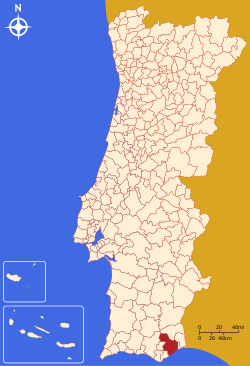Tavira Municipality
| Tavira | |||
|---|---|---|---|
| Municipality | |||

A street in Tavira
|
|||
|
|||
 |
|||
| Coordinates: 37°07′N 7°39′W / 37.117°N 7.650°WCoordinates: 37°07′N 7°39′W / 37.117°N 7.650°W | |||
| Country |
|
||
| Region | Algarve | ||
| Subregion | Algarve | ||
| Intermunic. comm. | Algarve | ||
| District | Faro | ||
| Parishes | 6 | ||
| Government | |||
| • President | Jorge Manuel Nascimento Botelho (PS) | ||
| Area | |||
| • Total | 606.97 km2 (234.35 sq mi) | ||
| Population (2011) | |||
| • Total | 26,167 | ||
| • Density | 43/km2 (110/sq mi) | ||
| Time zone | WET/WEST (UTC+0/+1) | ||
| Website | www.cm-tavira.pt/ | ||
Tavira (Portuguese pronunciation: [tɐˈviɾɐ]) is a Portuguese city and municipality, situated in the east of the Algarve on the south coast of Portugal. It is 28 kilometres (17 miles) east of Faro and 177 kilometres (110 miles) west of Seville in Spain. The Gilão River meets the Atlantic Ocean in Tavira. The population in 2011 was 26,167, in an area of 606.97 km².
Tavira's origins date back to the late Bronze Age (1.000-800 BC). In the 8th century BC it became one of the first Phoenician settlements in the Iberian West. The Phoenicians created a colonial urban center here with massive walls, at least two temples, two harbours and a regular urban structure. Phoenician Tavira existed until the end of 6th century BC, when it was destroyed by conflict.
It is thought its original name was Baal Saphon, named after the Phoenician Thunder and Sea god. This name later became Balsa.
After a century of being abandoned, the settlement recovered, during the urban bloom that characterised the so-called Tartessian Period, and became bigger than ever. This second urban center, Tartessian Tavira, was also abandoned by the end of the 4th century BC.
The main centre then moved to nearby Cerro do Cavaco, a fortified hill occupied until the time of Emperor Augustus.
During the time of Caesar, the Romans created a new port, some 7 kilometres (4 miles) from Tavira, named Balsa. Balsa became a big town, in fact much bigger than Tavira, that grew, prospered and decayed in parallel with the Roman Empire. When the Moors conquered Iberia, in the 8th Century, Balsa was already extinct as a town.
...
Wikipedia


